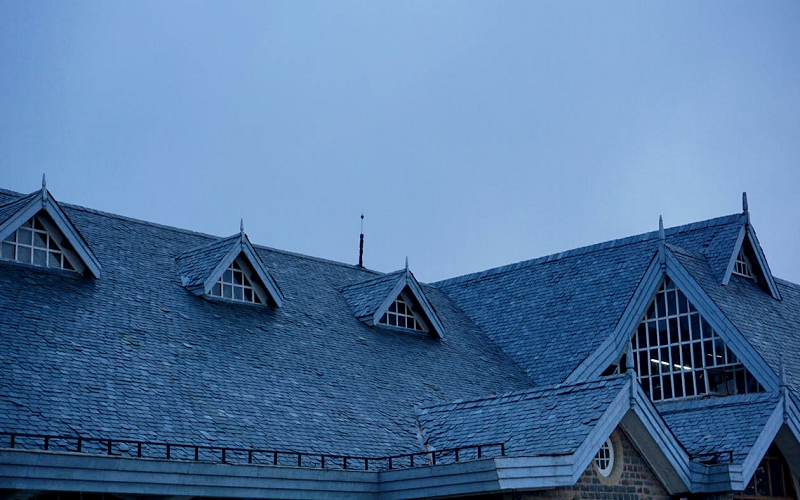Weather, mould, wear and tear, roofs are exposed to many risks. Risks which can lead to leaks which are not without consequences, but which are not inevitable either. Maison à part reviews the steps to take in the event of a leak and the good practices to avoid them.
Taking the sky on your head is not just an ancient fear. Roofs are indeed exposed to many dangers that can damage them and cause significant damage to our interiors. It can be the fall of dead leaves in the fall or mosses, climbing plants, tree branches, frost, etc. These elements can degrade covering, impairing the spontaneous flow of water, and causing the tiles to move. On the other hand, the storm risk has been ruled out because the regulations on the fixing of the tiles have been reinforced” explains Emilie Benjamin-Casadei, Head Market Roofing Tiles and Insulation at Terreal.
In the event of an aggravated leak, the load of water stored by the plaster and stored by the insulation can cause the entire roof to collapse. As water goes literally everywhere, it can also reach the electrical system. But not only: “infiltration can cause the wood to rot, weaken and cause the ceiling to fall. If water enters the insulation, this will create thermal bridges because the insulation characteristics of the insulating products are lost by the ‘air…’ develops Olivier Lafore, Edilians Marketing Communication and After-Sales Service Director.
Water-repellent treatment: little-known alternative to roof removal
To avoid the worst, experts invite us to anticipate. The individual must first keep a watchful eye on the risk areas . example, editor’s note) in its upper part. top of the roof windows is also a retention zone, where the water does not drain away” , explains Olivier Lafore. In the case of an L-shaped roof, the interior side of the L will have a valley generally embellished with a zinc corridor which can sometimes be blocked with leaves.
As a general rule, the experts invite you to check your roof, and more particularly these singular points,. More than controlling, the individual can also anticipate. When renovating his roof, he can decide to install an under-roof screen, which acts as additional waterproofing. It is not mandatory, although in France, 85% of individual houses are equipped with it. It lets the steam that comes from under the house circulate to the outside, while helping to fight against infiltration. Defoaming treatments
can also be applied. Regarding the durability of the tiles, this is not a particular point of vigilance. Manufacturers generally display a durability approaching 100 years, subject to good maintenance of course. Ideally, control and maintenance is carried out at the exit of the
to check that the freezing temperatures, frost and snow have not caused too much damage. But also in the fall to get rid of plants which, in the meantime, have had plenty of time to flourish and accumulate.
You haven’t been paying attention, and it’s the tile? Do not panic. Let’s first recall a golden rule on which professionals insist: do not tempt fate! Translation: do not act alone. n the meantime, the individual should not take the risk of starting the repairs himself ” . By playing the apprentice roofer , the individual puts himself in danger and takes the risk of worsening the state of his roof by walking on it.
As for how to secure the roof while waiting for repairs, again, caution is advised.”There is still the good old basin technique, but it’s very archaic. As for installing a tarpaulin on the roof, once again, it’s far too risky. Safety first!” insists Olivier Lafore.
Especially since locating a leak is not an easy task. Water can infiltrate at one point and come out several meters further. It is therefore up to an experienced roofer to establish a diagnosis in order to apply the right remedy.
Humidity in the house: how to get rid of it?
You still have to know how to choose the professional. To ensure the seriousness of a company, it is therefore preferable to favor word of mouth ” suggests Olivier Lafore. Or, if your relationship is in good shape, contact your insurer who may be able to refer you to trusted professionals.
In any case, it remains judicious to have several quotes drawn up and to compare them . Before signing, it is important to find out about the craftsman’s certifications, labels and guarantees.”Check the sites he has recently delivered, and check the financial strength of the company, on the internet or with the commercial court” suggests the Guide-toiture.com site.
Of course, before embarking on roofing work, you must be insured. There are two ways to proceed: by personal home insurance , which must include the roof and the work, and the ten-year roof guarantee insurance. The latter consists of “professional civil liability insurance for the craftsman who will carry out your work” , specifies Guide-toiture.com.
The craftsman must also be able to provide a ten-year roofing guarantee certificate. He must commit to the deadline for carrying out the work and submit a certificate of watertightness or conformity of the work at the end of the work.



